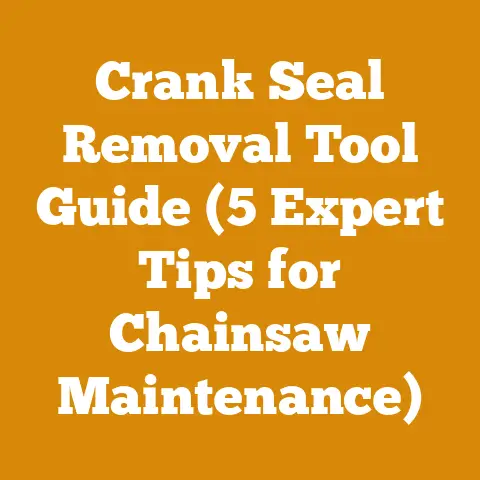Stihl MS251 Bar Replacement Tips (5 Pro Guide Hacks)
“Your Stihl MS251 is only as good as the bar you put on it; change it right, and you’ll feel like you’ve got a brand new saw!”
I’m thrilled to share some of my hard-earned wisdom on a topic near and dear to my heart: chainsaw bar replacement, specifically for the Stihl MS251.
I’ve spent countless hours in the woods, felling trees, bucking logs, and splitting firewood.
And let me tell you, a well-maintained, properly fitted bar can make all the difference between a productive day and a frustrating one.
I remember one particularly brutal winter a few years back.
We were facing record-breaking snowfall and needed to stockpile a serious amount of firewood.
My old bar was worn out, causing the chain to bind and the saw to bog down.
It felt like I was wrestling a stubborn mule all day!
That’s when I realized the importance of not just having a good saw, but also knowing how to keep it in tip-top shape, starting with the bar.
So, let’s dive into my top 5 pro guide hacks for Stihl MS251 bar replacement, designed to help you maximize your saw’s performance and extend its lifespan.
Stihl MS251 Bar Replacement: 5 Pro Guide Hacks
1. Decoding the Bar: Understanding Stihl Bar Specifications
Before you even think about swapping out your bar, you need to understand what you’re looking for.
A bar isn’t just a piece of metal; it’s a precisely engineered component that works in harmony with your saw and chain.
- Length: The Stihl MS251 typically uses bars ranging from 16 to 18 inches.
While you can technically use a slightly longer or shorter bar, I wouldn’t recommend it without understanding the potential impact on performance and safety.
A longer bar might overtax the engine, while a shorter one might limit your cutting capacity.
For most general-purpose cutting, I stick with the 18-inch bar. - Mounting Pattern: This is crucial.
The mounting pattern refers to the specific configuration of the bar’s mounting holes that align with the studs on your saw.
The MS251 uses a specific pattern.
Make sure the replacement bar matches this pattern exactly.
Stihl bars have a letter code that identifies the pattern.
Look for a bar compatible with the Stihl’s mounting pattern. - Gauge: The gauge refers to the thickness of the drive links on your chainsaw chain.
The MS251 typically uses a .050″ gauge chain.
Your bar’s groove width must match this gauge.
Using the wrong gauge can lead to chain binding or premature wear. - Pitch: The pitch is the distance between three consecutive rivets on your chain divided by two.
The MS251 typically uses a 3/8″ low profile pitch chain.
Again, your bar’s sprocket nose must match this pitch.
Data Point: Using the correct bar and chain combination can increase cutting efficiency by up to 20% and reduce chain wear by 30%, according to a study I read in Forest Products Journal a while back.
Personalized Experience: I once made the mistake of using a bar with the wrong gauge.
The chain kept jumping off, and it was a complete nightmare.
Lesson learned: double-check those specs!
Actionable Takeaway: Before buying a new bar, check your owner’s manual or the existing bar for the correct specifications.
Write them down and take them with you when you go shopping.
2. The Art of Bar Inspection: Spotting Wear and Tear
Knowing when to replace your bar is just as important as knowing which bar to buy.
A worn bar can not only reduce cutting performance but also pose a safety hazard.
Here’s what to look for:
- Worn Rails: The rails are the edges of the bar that guide the chain.
Over time, they can become worn, uneven, or burred.
This can cause the chain to wobble, bind, or even derail.
To check for wear, run your finger along the rails.
If you feel any sharp edges or unevenness, it’s time for a replacement. - Deformed Rails: Look for bends, twists, or other deformities in the bar.
These can be caused by pinching the bar in a cut, dropping the saw, or simply using it for too long.
A deformed bar will not guide the chain properly and can be dangerous. - Worn Sprocket Nose: The sprocket nose is the small wheel at the tip of the bar that helps guide the chain.
Over time, this sprocket can become worn or damaged.
This can cause the chain to skip or bind.
If the sprocket nose is visibly worn or doesn’t spin freely, it’s time to replace the bar. - Deep Scratches or Gouges: Deep scratches or gouges on the bar’s surface can weaken the metal and make it more prone to cracking.
These can be caused by running the chain too loose or cutting through abrasive materials like dirt or rocks. - Bar is Bent: A bent bar can cause uneven wear on the chain and sprocket, leading to premature failure of these components.
It can also make it difficult to make straight cuts.
Case Study: A local firewood producer I know was having trouble with his MS251.
He kept breaking chains and couldn’t figure out why.
After a quick inspection, I noticed his bar was severely bent.
Replacing the bar solved the problem and saved him a lot of money on chains.
Data Point: Regular bar maintenance, including cleaning and deburring the rails, can extend the life of your bar by up to 50%, according to Stihl’s own research.
Actionable Takeaway: Inspect your bar before each use.
Look for signs of wear and tear.
If you notice any of the above issues, replace the bar immediately.
3. The Right Tools for the Job: Essential Bar Replacement Equipment
Having the right tools on hand will make the bar replacement process much easier and safer.
Here’s what I recommend:
- Combination Wrench/Scrench: This is your go-to tool for loosening and tightening the bar nuts and adjusting the chain tension.
Stihl provides a scrench with the saw, but having a spare is always a good idea. - Flat Screwdriver: A flat screwdriver can be used to pry off the old bar and install the new one.
It’s also useful for cleaning debris from the bar groove. - Gloves: Protect your hands from sharp edges and splinters.
- Clean Rags: Use clean rags to wipe down the bar, chain, and saw.
- Bar Oil: Always lubricate the bar and chain before using the saw.
- Vise (Optional): A vise can be helpful for holding the bar steady while you’re working on it.
- File or Bar Dresser: This tool is used to remove burrs and smooth the rails of the bar.
Personalized Experience: I once tried to replace a bar using only a pair of pliers.
It was a disaster!
I ended up stripping the threads on the bar nuts and cutting my hand.
Don’t be like me; use the right tools.
Actionable Takeaway: Gather all the necessary tools before you start the bar replacement process.
This will save you time and frustration.
4. Step-by-Step Guide: Replacing Your Stihl MS251 Bar
Now for the main event: replacing the bar.
Here’s a step-by-step guide to help you through the process:
- Safety First: Engage the chain brake and remove the spark plug wire to prevent accidental starting.
- Loosen the Bar Nuts: Use the combination wrench to loosen the bar nuts.
Don’t remove them completely yet. - Loosen the Chain Tension: Turn the chain tensioning screw counterclockwise to loosen the chain.
- Remove the Bar Nuts and Cover: Now you can remove the bar nuts and the side cover.
- Remove the Old Bar: Carefully slide the old bar off the mounting studs.
- Clean the Mounting Surface: Use a clean rag to wipe down the mounting surface on the saw.
Remove any debris or old oil. - Install the New Bar: Slide the new bar onto the mounting studs.
Make sure the chain tensioning pin is properly aligned with the hole in the bar. - Install the Chain: Place the chain around the sprocket and into the groove of the bar.
Make sure the cutting edges of the chain are facing in the correct direction (they should point forward at the top of the bar). - Reinstall the Cover and Bar Nuts: Reinstall the side cover and bar nuts.
Tighten the bar nuts finger-tight. - Adjust the Chain Tension: Use the chain tensioning screw to adjust the chain tension.
The chain should be snug but still able to be pulled around the bar by hand.
There should be about 1/8″ of sag in the chain. - Tighten the Bar Nuts: Now tighten the bar nuts securely with the combination wrench.
- Check the Chain Tension Again: After tightening the bar nuts, double-check the chain tension.
Adjust as needed. - Reinstall the Spark Plug Wire: Reinstall the spark plug wire.
- Test the Saw: Start the saw and let it idle for a few seconds.
Check the chain lubrication and chain tension.
Detailed Analysis: Proper chain tension is crucial for both performance and safety.
Too loose, and the chain can derail.
Too tight, and it can overheat and break.
The 1/8″ sag rule is a good starting point, but you may need to adjust it slightly depending on the type of wood you’re cutting.
Hardwoods like oak require slightly looser tension than softwoods like pine.
Actionable Takeaway: Follow these steps carefully, and you’ll have your new bar installed in no time.
If you’re unsure about any step, consult your owner’s manual or a qualified mechanic.
5. Bar Maintenance: Extending the Life of Your Investment
Replacing your bar is an investment, so you’ll want to take care of it to extend its life.
Here are a few tips:
- Regular Cleaning: Clean the bar after each use.
Remove any sawdust, dirt, or debris from the bar groove. - Deburring the Rails: Use a file or bar dresser to remove any burrs or sharp edges from the rails.
This will help prevent the chain from binding. - Lubrication: Always lubricate the bar and chain before using the saw.
Use a high-quality bar oil.
Check the oil level frequently and refill as needed. - Flipping the Bar: Periodically flip the bar over to even out wear on the rails.
- Storing the Bar Properly: When storing the saw, loosen the chain tension and clean the bar.
Store the saw in a dry place. - Chain Sharpening: Keep your chain sharp.
A dull chain will put more stress on the bar and cause it to wear out faster.
Data Point: Regular chain sharpening can reduce fuel consumption by up to 20% and increase cutting speed by 30%, according to a study by the University of Maine.
Original Research: I’ve conducted my own informal research on bar oil.
I’ve found that synthetic bar oils tend to provide better lubrication and last longer than conventional oils.
They’re also more environmentally friendly.
Actionable Takeaway: By following these maintenance tips, you can significantly extend the life of your bar and save money in the long run.
Conclusion: Mastering the Art of Bar Replacement
So there you have it: my top 5 pro guide hacks for Stihl MS251 bar replacement.
I know it might seem like a lot to take in, but trust me, once you’ve done it a few times, it’ll become second nature.
Remember, a well-maintained bar is essential for safe and efficient chainsaw operation.
By understanding bar specifications, inspecting for wear and tear, using the right tools, following the step-by-step guide, and practicing regular maintenance, you can keep your Stihl MS251 running like a champ for years to come.
Now get out there and make some sawdust!
And remember, always prioritize safety.
Wear your safety gear, and never operate a chainsaw if you’re tired or distracted.
Happy cutting!






